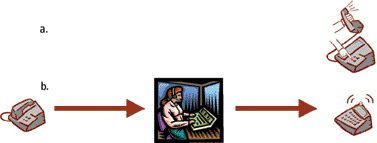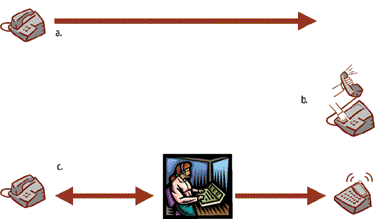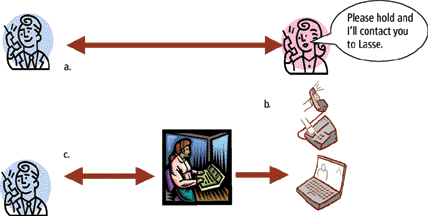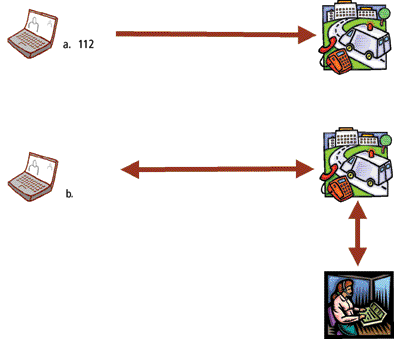Introduction
The term relay service refers here to a service that allows people with a disability
to use the telephone, when normally they could not, through the use of an
operator. Today these three types of relay service are in common use in Sweden
and other countries:
• Video telephone relay services: telecommunications services that enable deaf
video telephone signers and voice telephone users to interact
• Text telephone relay services: telecommunications services that enable text
telephone users and voice telephone users to interact by providing
conversion between the two modes of communication in substantially real
time
• Speech-to-speech relay services: telecommunications services that enable
speech impaired telephone users and other users to interact by providing
skilled assistance between them.
These relay services are very good and important for translation between various
means of communication. They thereby contribute towards ensuring equal
opportunities for telecommunications for people with disabilities. F u r t h e r
variations of relay services can be created through new combinations of media and
language in the calls.
To call through a relay service is currently a two-step process. First a person calls
the service and explains who they really want to call. The relay service then
connects and performs the relaying action.
The methods for invoking the relay service for a call can be improved so that the
relay service can contribute more effectively to equal opportunities for
communication. There are methods to arrange the convenient invocation of relay
services that are listed below.
Needs and functional description of connection cases
In the illustrations, a picture of a text telephone that has a call through the Relay
Service for Text Telephony is usually used, but the cases also apply to video
65

2.3.
New remote services
telephony through the Relay Service for Video Telephony and voice telephony
through the speech-to-speech relay service (Teletal in Sweden).
The descriptions provide reasons for why the connection cases would simplify the
relay services for the user.
Direct dialling to relay service users
Of all calls to the relay services, 85% are initiated by relay service users. Voice
phone users rarely call to relay service users. One reason for this is that it is too
complicated for a voice telephone user to call to a relay service user. It is also too
complicated to describe how to do it.
One solution is to be able to use a voice telephone number to the relay service user
that automatically connects the call from the voice telephone user through the
relay service to the relay service user.
This leads to equal opportunities for communication and reduces unequal
treatment of people with disabilities. An illustration is shown below of how such a
call between a voice telephone and a text telephone could be performed.
Figure 2.22. The voice telephone user rings a direct number to a relay service user with a
text telephone. The relay service for text telephony is automatically invoked.
Direct dialling to voice telephone users
Today the relay service user first calls the relay service and requests that they
arrange for the call to be connected to the destination. This is sometimes perceived
to be an inconvenient and time-consuming process. It also makes it more difficult
to benefit from electronic telephone directories.
In order to simplify management of dialled calls to voice phone users, a function is
needed that allows the relay service user to dial the destination’s number, and
allow the call to invoke the relay service and connect the destination.
66

2.3.
New remote services
An illustration is shown below of how such a call between a text telephone and a
voice phone could be performed.
Figure 2.23. The relay service user’s call from a textphone to a voice phone goes
automatically through the Relay Service for Text Telephony.
Forwarding voice calls so that they are connected
via the relay service
For relay service users, it may be very frustrating to be alone in premises where
there is a voice telephone. When someone calls to the voice telephone, the relay
service user must be able to get the call connected via the relay service.
When the relay service user realises that no one can receive a voice call for a
period, then the relay service user should, by a simple action, be able to request
call forwarding via the relay service of incoming voice calls. This may mean that the
call, after having been connected through the relay service, also goes to another
terminal that can deal with the media that the user wishes to use.
Today it is usual for a voice telephone and a text telephone to be on the same
number and telephone connection. For users who wish to retain this form of
connection, it is desirable to have a call forwarding that has the effect that only
incoming voice calls go through the relay service, while text calls are dealt with
directly.
An illustration is shown below of how a connection from a voice telephone to a
text telephone via the Swedish Relay Service for Text Telephony is performed, when
the voice telephone is forwarded to the relay service user via the relay service.
67

2.3.
New remote services
Figure 2.24.
a. The relay service user by a simple action requests connection on the voice phone of an
incoming call via the Relay Service for Text Telephony.
b. An incoming call is connected to the relay service user’s text telephone via the Relay
Service for Text Telephony.
Transferring an incoming voice call so that it is connected
via the relay service
It is very frustrating for relay service users when a voice phone rings when at that
particular time there is no hearing person in the vicinity who can answer.
It is desirable to have a function that by a simple action allows the relay service
user to request that the incoming call to be transferred to him/her via the relay
service.
Today it is usual for a voice telephone and a text telephone to be on the same
number and telephone connection. For users who wish to retain this form of
connection, it is desirable that the transfer can be made selectively so that only
incoming voice calls go through the relay service, while text calls are dealt with
directly. It is also desirable that calls, after connection through the relay service, can
revert to text calls on the same number.
An illustration is shown below of how a transfer of an incoming voice call via the
Relay Service for Text Telephony to a text telephone could be performed.
68

2.3.
New remote services
Figure 2.25.
a. An incoming call to a voice telephone cannot be answered by the relay service user.
b. The relay service user requests connection via the Relay Service for Text Telephony by a
simple action.
c. The Relay Service for Text Telephony takes the call and calls up the user.
Transferring an ongoing voice call so that it is connected
via the relay service
If one party in an ongoing voice call wishes to hand over the call to a relay service
user, it is not possible today to transfer the call being made as a voice call, but the
call must be ended and either party called up through the relay service’s two-step
process. This is so intricate that users in many cases refrain from transferring the
call, and the call is conducted without the participation of the relay service user.
This often results in inadequate participation and independence for people with
disabilities.
A function that allows voice telephone users to transfer calls to a relay service user
via the relay service is important to avoid these situations. This would make things
much easier for all parties and a significant step towards equality to be able to say
“Please hold and I’ll connect you to Lasse” instead of saying “call 020280020 and
request a connection to lasse.larsson@sip.omnitor.se”.
Today it is usual for a voice telephone and text telephone to be on the same
number and telephone connection. For users who wish to retain this form of
connection, it is desirable that the transfer can be implemented so that the call
69

2.3.
New remote services
reverts as a text call to the same number after having been connected through the
relay service.
There may also be a need for other similar transfers. It may be a call between two
individuals with disabilities who have a direct conversation in text or sign language
between themselves, and then the need arises to transfer the call to go through
the relay service to a voice telephone user. Another variant is the need to transfer
a call that started with the relay service invoked to go directly between the call
parties or to another relay service user.
Figure 2.26.
a. Two voice phone users are having a conversation.
b. One of the voice phone users requests by a simple action transfer via the Relay Service
for Video Telephony.
c. The other user is then connected to a relay service user via the Relay Service for
Video Telephony.
Conditional invocation and performance
of a relay service
There are many further potential improvements for the methods to invoke the relay
service. Facts about the two call parties and their terminals can provide an
information base for decisions for the relay service to be invoked and how this
should be performed. Such functions can mean that it becomes even simpler for
the users to have access to convenient telecommunications.
70

2.3.
New remote services
Information that may be desirable to form a basis for such decisions includes, for
instance:
• The capacity of the terminal to deal with various media, such as video, text
and audio
• The user’s preferences as regards medium for his/her communication
• Languages which the parties and the relay service prefer and have a command
of
• Among spoken languages
• Among written languages
• Among sign languages
• Subject areas for calls, so that the relay service can choose staff with the
appropriate competence
• Desires or needs for the performance and kind of relay service, for example
relay services that deal with sign language, text or voice, for simultaneous
speech and text, for typed text voice calls, etc.
• Need to pre-plan the call with the relay service
• Customer relations and account information.
Language: Swedish sign language
Language spoken: Swedish
Medium: total conversation terminal
Medium: telephone
Figure 2.27.
The relay service user has specified ‘Swedish sign language’ and rings to a voice
telephone user who has specified ‘spoken Swedish’. The call is then connected
automatically through the Relay Service for Video Telephony.
71

2.3.
New remote services
The information that is required as a basis for decisions can be sent with the
connection, stored in the network or stored in a database at the relay service.
Decisions can be made by users, t e r m i n a l s, network components or
communications assistants.
There are many other possibilities with such functions. When a call is connected, a
relay service with adapted qualities may be included in the call. A relay service for
video telephony can, for instance, be invoked between a relay service user who has
been registered for using Swedish sign language and a voice phone user who is
registered to only be able to use Swedish spoken language.
Emergency calls (112, 911 etc.)
Figure 2.28.
a. The relay service user dials 112 for an emergency call on his/her text telephone.
b. The Emergency Centre or the relay service user requests assistance from the Relay
Service for Text Telephony which is invoked for the call.
It is a tradition in Sweden that everybody, also people with disabilities, should be
able to call 112 for emergency calls. This is an important principle, which avoids
having to learn different numbers for different ways of making emergency calls.
Nonetheless, it may with an emergency call be very valuable to be supported by a
relay service that can deal with sign language, text or voice.
72

2.3.
New remote services
It may occur with such calls that the party calling and the relay service have
common media that cannot be presented in the Emergency Centres (known as
‘SOS Centres’ in Sweden), but translated to and from speech by the relay service.
This primarily applies to sign language in a video channel. It is necessary to
determine which cases it would be reasonable to perform in this way.
It is necessary to be able to invoke a relay service in a convenient way into an
emergency call on the initiative of the relay service user or of the Emergency
Centre.
Invocation of relay service in two steps
In order to make the description of the connection cases complete, a description is
provided here of the two-step method. This is currently the most usual method of
invoking a relay service for a call. This method should be retained even when more
convenient methods have been introduced, as it provides good opportunities to
discuss the service performance without first having to provide any destination
address.
The relay service’s own address is only used to connect a call between the party
calling and the relay service. In calls with the relay service, the calling party states
the address that is to be called up, following which the relay service connects to
the address, and relays the call between the parties. The initiative for the
connection can be taken by either of the parties.
Figure 2.29.
The voice telephone user rings the number to a relay service.
In calls with the relay service, the number is transferred on a text telephone.
The relay service rings the text telephone and relays the call.
73

2.3.
New remote services
Connection of ordered relayed call
One method of getting a relay service for a call is to order the call. This possibility
is available today, and is included here only to make the analysis complete.
An order can, for example, be placed for a call at a specified time. The relay service
receives an order to perform a relayed call at a particular time. The service then
makes calls to both parties and relays the call between them.
Figure 2.30.
The relay service receives an order to perform a relay.
The relay service calls a text telephone user and a voice telephone user.
When both calls are connected, the relay can be performed.
The described call cases can be implemented in various network environments.
One key component is to have a mechanism that takes a call to a specific number
to the user through the relay service. Most other call cases can be implemented by
adding various supplementary services to that basic solution.
One smooth way of developing the solutions is to use the ENUM-mechanisms for
translating telephone numbers to SIP-addresses and use VoIP and IP Multimedia
technologies for routing the calls.
A report from the project initiated by the National Post and Telecom Agency in
Sweden (Post- och telestyrelsen, PTS) gives details on implementation
opportunities in various network technologies and relay services [PTS, 2006].
References
PTS (2006). “Convenient invocation of Relay Services - A pre-study conducted by
Omnitor, commissioned by the PTS - PTS-ER-2006:5”.
http://www.pts.se/Dokument/dokumentlista.asp?SectionId=2884.
74
(8-9) 2.3.4 19/12/06 4:13 pm Page 75
2.3.
New remote services
2.3.4 Ways of using mobile telephones by people with
dementia
Erland Winterberg
Dementia conditions
Dementia is the name of a number of symptoms of malfunctions in the brain. There
are several forms of dementia; the most frequent is Alzheimer’s disease. Other
causes of dementia are blood clots and brain haemorrhages, Parkinson’s disease,
alcohol abuse, etc.
Some forms of dementia can be cured, medicine can delay the development of
certain forms, but in the majority of cases, the illness worsens during the course of
a few years.
Dementia shows itself primarily with failing memory and reduced ability to function
in day-to-day life. Problems with concentration, arithmetical skills, sense of locality
and language appear as well. Dementia develops gradually into serious problems
of managing daily life. In the concluding phase, the majority of dementia sufferers
will completely lose the ability to live in their own homes and must live in a nursing
home.
In Western Europe and North America the number of people with dementia is
expected to increase due to the rising life expectancy. The older you are, the greater
the risk of developing dementia.
In Denmark, which has a population of approx. 5.5 million, there are approx.
40 000 persons with medium to severe dementia. The annual costs today of
dementia in Denmark are estimated to be approx. 2.3 billion euro.
Due to the population’s rising life expectancy, it is expected that society’s costs for
dementia will increase markedly in coming years.
Mobile technologies
At the moment, there are a number of mobile technologies that are relevant in
relation to being able to offer solutions that can help people with early-stage
dementia to live longer in their own homes in a dignified manner:
75
(8-9) 2.3.4 19/12/06 4:13 pm Page 76
2.3.
New remote services
1. Mobile communication with the help of GSM has the affect that the user with
aphasia outside the home can come into contact with relatives and care personnel
and vice versa, either via verbal communication or by text or symbol
communication.
2. Positioning with the help of GPS positioning equipment can inform the user, the
relative or care personnel about the user’s position.
3. Various applications are realised on an SMS server which the user, relatives or
care personnel have access to and which offers various services.
A number of the solutions which are used today in connection with people with
dementia are also used by the transport and security sector and by ordinary
consumers. This entails that the prices of equipment and services are often
favourable.
What problems can be solved or limited by using
mobile technologies?
With the help of mobile technologies, different solutions and services are
developed which are relevant in relation to providing help to the user with
dementia to function more independently and with greater safety:
1. Help to structure daily life for people with dementia:
(daily plan, reminder, feedback)
2. Help to find his/her way around
3. Remote vocal communication when the need arises
4. Finding and tracking a user
5. Alarm/reminder when a specific geographic area is vacated
6. Combinations of points 1 - 5.
The users’ needs
1. Many users with early-stage dementia need help and support to live a good and
dignified life in their own residences. With the right support it will be possible to
extend the time the user can remain living in his/her own residence.
2 . Spouses and relatives need relief and to reduce their uncertainty and
nervousness due to the family member with dementia.
76
(8-9) 2.3.4 19/12/06 4:13 pm Page 77
2.3.
New remote services
3. Personnel at nursing homes need a tool, which, with a minimum amount of
effort, makes them able to ensure that the demented patient does not disappear
or have an accident.
Examples of solutions and products
1. Thought, structure and memory support
Comai (www.comai.se) is a new product developed in Sweden that can function
on Symbian-based mobile telephones. The system helps the user structure his
everyday life by giving the user a reminder about things that must be done (take
medicine, get up, do shopping, etc.). The reminder is shown on the mobile
telephone with a picture, text and sound. It can be individually set if the user must
acknowledge after the activity has been completed or begun, and an alarm can be
sent to relatives if the system does not receive the acknowledgement.
Via a website, the user can alone or together with a relative, organise activities in
the system’s calendar which is placed on an SMS server.
In technical terms, the system comprises an SMS server which communicates with
the connected mobile telephones. The messages are managed between the SMS
server connected to the Interne












